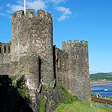CAERPHILLY
CASTLE
Wales Largest Medieval Castle
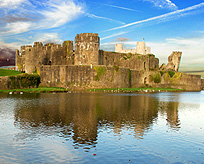 Caerphilly
Castle in South Wales is one of the most spectacular of medieval castles
of
Europe, the largest castle in Wales and second largest in
Britain after Windsor (see Windsor Castle). Caerphilly is noted for its photogenic setting, circled by a wide moat formed from the flooding of a natural depression with the waters of the Nant Gledyr stream, creating a large defensive lake to the south of the main castle. In castle architecture, Caerphilly was the first castle built of the concentric walls and round towers design, with four gates blocking approach from several bridges across the moats. The castle and its posterns occupy three islands surrounded by open greens in the center of town. While North Wales is known for the "Iron Ring" castles built by Edward I (see Caernarvon Castle), the photogenic fortress at Caerphilly is not
one of them.
Caerphilly
Castle in South Wales is one of the most spectacular of medieval castles
of
Europe, the largest castle in Wales and second largest in
Britain after Windsor (see Windsor Castle). Caerphilly is noted for its photogenic setting, circled by a wide moat formed from the flooding of a natural depression with the waters of the Nant Gledyr stream, creating a large defensive lake to the south of the main castle. In castle architecture, Caerphilly was the first castle built of the concentric walls and round towers design, with four gates blocking approach from several bridges across the moats. The castle and its posterns occupy three islands surrounded by open greens in the center of town. While North Wales is known for the "Iron Ring" castles built by Edward I (see Caernarvon Castle), the photogenic fortress at Caerphilly is not
one of them.
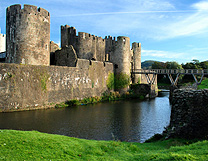 Caerphilly Castle was built primarily between 1268 to 1272 by Gilbert “The Red” De Clare, the Earl of Gloucester and Lord of Glamorgan, to block the threat from the last Welsh Prince of Gwynedd in a long running dispute under Henry III. Gilbert "The Red", was a descendent of the one of the great powerful families of Norman England. The first Gilbert de Clare fought alongside William I "The Conquerer" and felt a strong claim on the throne of England. Gilbert "The Red" was the grandson of Richard De Clare, the “Strongbow” of Ireland
(see Dublinia and Christ Church), the one time Earl of Pembroke who lost
that title to William Marhsal in a power contest with Henry II, wary
of the challenge of the De Clares (see Pembroke
Castle). Gilbert consolidated his hold on the lands in Wales and for the most part ended the conflict with the Plantagenets by marrying Joan of Acre, a daughter of Edward I, born on crusade, only to see the castle and lands granted to the Despensers under her brother Edward II, contributing to the near overthrow of the English throne by the Welsh Marcher barons under Roger Mortimer (see Mortimer's Hole).
Caerphilly Castle was built primarily between 1268 to 1272 by Gilbert “The Red” De Clare, the Earl of Gloucester and Lord of Glamorgan, to block the threat from the last Welsh Prince of Gwynedd in a long running dispute under Henry III. Gilbert "The Red", was a descendent of the one of the great powerful families of Norman England. The first Gilbert de Clare fought alongside William I "The Conquerer" and felt a strong claim on the throne of England. Gilbert "The Red" was the grandson of Richard De Clare, the “Strongbow” of Ireland
(see Dublinia and Christ Church), the one time Earl of Pembroke who lost
that title to William Marhsal in a power contest with Henry II, wary
of the challenge of the De Clares (see Pembroke
Castle). Gilbert consolidated his hold on the lands in Wales and for the most part ended the conflict with the Plantagenets by marrying Joan of Acre, a daughter of Edward I, born on crusade, only to see the castle and lands granted to the Despensers under her brother Edward II, contributing to the near overthrow of the English throne by the Welsh Marcher barons under Roger Mortimer (see Mortimer's Hole).
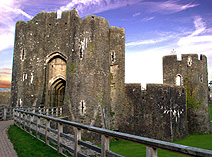 Caerphilly Castle actually saw few real assaults, an unsuccessful attack in 1294 during the revolt of Madog ap Llywelyn, a more intense assault in 1316 in the Welsh rebellion led by Llywelyn Bren, and brief occupations by the forces of Owain Glyndwr, in the last serious Welsh revolt of 1403 and 1405. One of the castle’s more distinctive features is the leaning tower, which was thought to have been damaged during the English Civil War, though no significant battle took place there. The other theory is the leaning tower is the victim of the natural subsidence of the land. In either case, remarkably, the shard of stonework wall has stood at an impossible angle for several hundred years.
Caerphilly Castle actually saw few real assaults, an unsuccessful attack in 1294 during the revolt of Madog ap Llywelyn, a more intense assault in 1316 in the Welsh rebellion led by Llywelyn Bren, and brief occupations by the forces of Owain Glyndwr, in the last serious Welsh revolt of 1403 and 1405. One of the castle’s more distinctive features is the leaning tower, which was thought to have been damaged during the English Civil War, though no significant battle took place there. The other theory is the leaning tower is the victim of the natural subsidence of the land. In either case, remarkably, the shard of stonework wall has stood at an impossible angle for several hundred years.
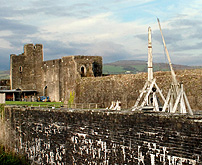 The castle was maintained as a strategic defense through the 15th Century, but mostly abandoned after the death of Jasper Tudor in 1495, used as many old fortresses as a prison for a time, with restorartion undertook by the Marquesses of Bute who took ownership in 1766. Much of the castle as seen today was restored in the 1930’s. Never suitable as a noble estate and in the center of the town of Caerphilly, the castle was turned over to the government in 1950, now adminstered by Cadw.
The castle was maintained as a strategic defense through the 15th Century, but mostly abandoned after the death of Jasper Tudor in 1495, used as many old fortresses as a prison for a time, with restorartion undertook by the Marquesses of Bute who took ownership in 1766. Much of the castle as seen today was restored in the 1930’s. Never suitable as a noble estate and in the center of the town of Caerphilly, the castle was turned over to the government in 1950, now adminstered by Cadw.
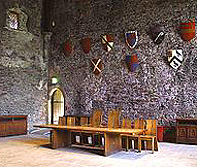 The views of the castle had for a time been obscured by the growth of the city around it, but with redevelopment, it is clearly ready for its photogrpahic close-up from its southside acoss the lake which surrounds it. The castle’s Great Hall can be rented out for weddings and historic exhibits can be viewed in the main outer gatehouse. Replica Trebuchet siege machines sit out on the dam wall which was once a tournament field (see Medieval
).
The views of the castle had for a time been obscured by the growth of the city around it, but with redevelopment, it is clearly ready for its photogrpahic close-up from its southside acoss the lake which surrounds it. The castle’s Great Hall can be rented out for weddings and historic exhibits can be viewed in the main outer gatehouse. Replica Trebuchet siege machines sit out on the dam wall which was once a tournament field (see Medieval
).
Visiting Caerphilly Castle
The castle at Caerphilly is open daily from 9:30am to 6pm in summer, until 5pm in spring and autumn, and in winter from 9:30am to 5 pm Monday to Saturday and 11am to 4pm on Sunday. Last entrance is 30 minutes before closing. Admission for adults is £3.60, Student and Seniors, £3.20 with a family ticket available for £10.40. A modern visitor’s center is located across the street with pay and display parking. There is also some restricted street parking around the moat park. Caerphilly Castle is the one closest of the great walled castles to Cardiff, about 15 minutes by car. © Bargain Travel Europe
Compare hotel and travel deals in Wales on TripAdvisor
Web Info
Cadw
- Caerphilly
These articles are copyrighted and the sole property of Bargain Travel Europe and WLPV, LLC. and may not be copied or reprinted without permission.
SEE ALSO:
CAREW CASTLE & TIDAL MILL - TENBY
DINEFWR CASTLE PARK AND NEWTON HOUSE
ST DAVID’S BISHOP’S PALACE AND CATHEDRAL
DYLAN THOMAS - BOATHOUSE AND SWANSEA
LAUGHARNE CASTLE - ROMANTICS RUIN

